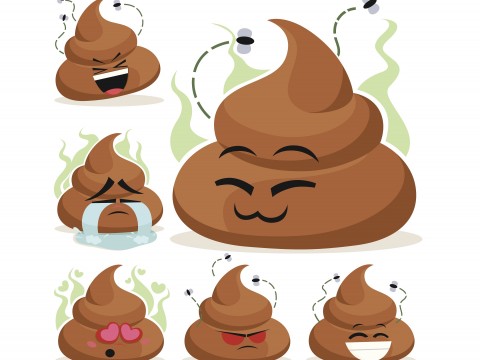

Until you become a mom, poop is just poop. Everything changes when you have a baby. In fact, you might as well consider that very first poopy diaper—meconium—your induction. Welcome to the world of asking yourself, “Is this poop normal?”
You’ll quickly understand why moms tend to obsess about poop, because what comes out of your baby gives you lots of clues about what’s going on inside her body. For example, as your baby grows and her diet changes, her poop will change too. You could say poop takes some of the guesswork out of motherhood.
That first crazy poop
You can read about meconium and hear stories about it from your mommy friends, but nothing really prepares you for it. It’s honestly one of the craziest first experiences as a new parent. Meconium is like a thick, sticky, dark poo—tarlike—that surprisingly has no odor. It’s impossibly hard to clean up, especially on a tiny newborn.
Meconium is not a typical poo, because your baby has not been eating typical meals in utero. Your baby has been swallowing amniotic fluid in preparation for breastfeeding. The by-product of this is an intestinal secretion called meconium. It consists of bile salts, bile acids and other debris.
Green with seeds
Uhm, yes, you just read that correctly. As your baby passes the black meconium, it will gradually change color and consistency based on what your baby is ingesting. It usually takes 24-72 hours for your newborn to pass the meconium.
If you’re breastfeeding, her poo will turn dark green with a consistency that looks like Dijon mustard — it looks like there are seeds in it. If you’re feeding your baby formula, the meconium changes from black to green to light brown.
Transitional poo is good
Even though it sounds rather icky, when you start noticing her poop is no longer like tar, that’s good news. It means she’s digesting her breast milk or formula, and her intestinal tract is doing its job.
It keeps changing
Just when you think you’ve got your baby’s poop figured out, it changes. Most moms have more than a few “uh-oh” moments when they discover a new poo. The color and consistency can change even if your baby’s diet seems like it’s exactly the same. Why? Because if you’re breastfeeding, changes in your diet can impact your baby’s poop.
What’s a “normal” poop
Believe it or not, even on a strict diet of breast milk, baby’s poop can vary. This means “normal” poop differs from baby to baby. It could be green or yellow and mushy or it could be very runny, or once again, it could look like Dijon mustard.
Formula fed babies usually have a slightly thicker poo—think peanut butter consistency. Colors tend to be brown with greenish or tan shades. It’s a little bit smellier than poop from a breastfed baby.
If you see more shades of green than normal and you’re breastfeeding, it probably just means you ate something different. Unless your baby is exhibiting symptoms that she isn’t feeling well, tinges of green are nothing to worry about.
The baby poop you were expecting...
By the time your baby is eating solid foods like infant cereal or pureed foods, her poop will change again. With the introduction of solid foods, her poop will firm up a bit and change to a brown or dark brown color. It could still be rather mushy, but it will be twice as smelly.
Throughout your baby’s diet journey, make sure you use Boudreaux’s Butt Paste® to protect her skin from diaper rash. Changes in bowel movements can impact pH levels, making her skin more susceptible to irritation.


